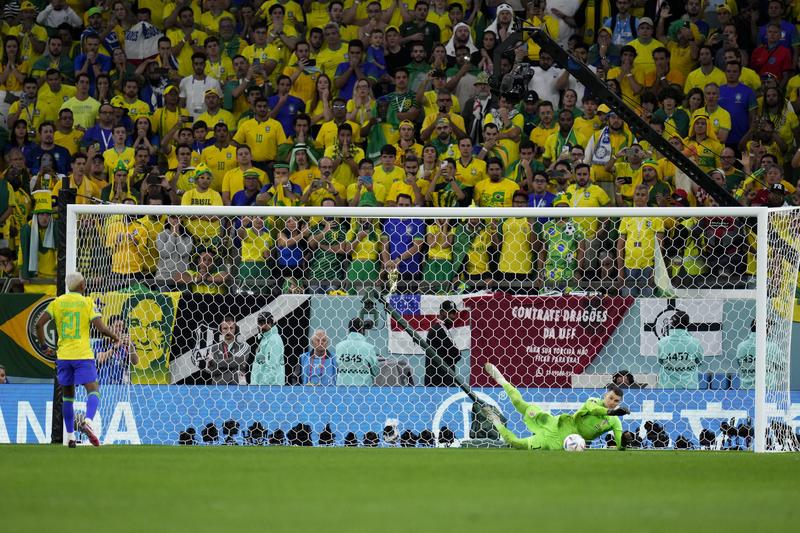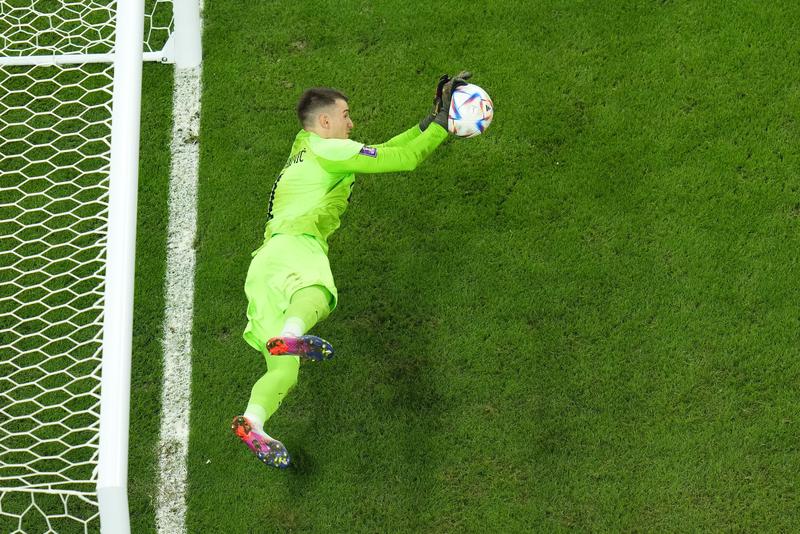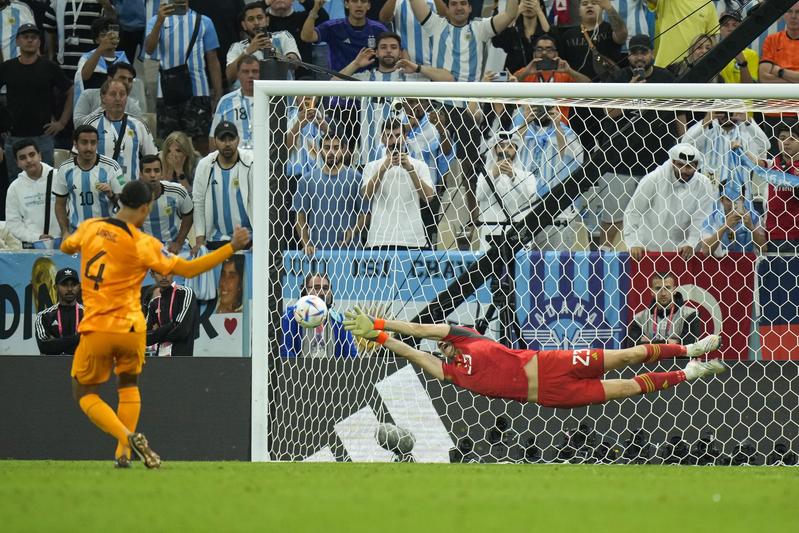 Croatia's goalkeeper Dominik Livakovic stops a penalty kick from Brazil's Vinicius Junior during the penalty shootout in the World Cup quarterfinal soccer match between Croatia and Brazil, at the Education City Stadium in Al Rayyan, Qatar, Dec 9, 2022. (MANU FERNANDEZ / AP)
Croatia's goalkeeper Dominik Livakovic stops a penalty kick from Brazil's Vinicius Junior during the penalty shootout in the World Cup quarterfinal soccer match between Croatia and Brazil, at the Education City Stadium in Al Rayyan, Qatar, Dec 9, 2022. (MANU FERNANDEZ / AP)
DOHA/LONDON - It is short odds that there will be a penalty shootout at the World Cup over the next two days. There has been at least one in the quarterfinals of the last nine tournaments, peaking in 1986 when three of the four matches went to penalties.
Few of those, however, can have featured a set of spot kicks as poor as in the last-16 games in Qatar. Japan went out with a whimper as Croatia keeper Dominik Livakovic saved tame efforts Takumi Minamino, Kaoru Mitoma and Maya Yoshida were all denied by Livakovic.
Spain coach Luis Enrique was firmly in the "it's not a lottery" camp, saying before his team's last 16 clash with Morocco that he had told the players to take 1,000 practice penalties when with their clubs.
Data company Nielsen Gracenote has analyzed all penalties taken at the last five World Cups, including Qatar, and found that shooting low to the right (50 percent) or left (68 percent) has the lowest success rate - and even those figures don't factor in how far to the right or left
Either they weren't listening or it didn't work as the first three players to attempt one all failed to convert. Pablo Sarabia, who was brought on at the end of the match for just for that job, hit the post while Carlos Soler and Sergio Busquets had their tame efforts comfortably saved to send Morocco through.
READ MORE: Messi's Argentina go through on penalties after Dutch comeback
Having also gone out at the same stage on penalties to Russia four years ago, it was an inexplicable performance by a team containing some of the most technically talented players in the sport.
The most notable aspect of both 2022 shootouts was the shockingly poor quality of the kicks. The six penalties missed by the losing teams were all struck without much power and most not right in the corner, a strategy that left fans and experts scratching their heads and gave the keepers easy wins.
Data company Nielsen Gracenote has analyzed all penalties taken at the last five World Cups, including Qatar, and found that shooting low to the right (50 percent) or left (68 percent) has the lowest success rate - and even those figures don't factor in how far to the right or left.
READ MORE: Van Gaal hails effort of players and bemoans penalty misses
Unsurprisingly, shots into the top area, whether wide or central, have a 100 percent conversion rate - 20 attempts in this study. Although there might appear more risk in going high, only five penalties have hit or gone over the bar in that time, while seven have hit a post or gone wide.
 Croatia's goalkeeper Dominik Livakovic saves a shot during a penalty shootout during the World Cup quarterfinal soccer match between Croatia and Brazil, at the Education City Stadium in Al Rayyan, Qatar, Dec 9, 2022. (PETR DAVID JOSEK / AP)
Croatia's goalkeeper Dominik Livakovic saves a shot during a penalty shootout during the World Cup quarterfinal soccer match between Croatia and Brazil, at the Education City Stadium in Al Rayyan, Qatar, Dec 9, 2022. (PETR DAVID JOSEK / AP)
Former England striker Alan Shearer had a brilliant penalty record, achieved by usually smashing the ball high into a corner so that even if a goalkeeper dived towards it, he had no chance of saving it.
Body language
So why do so many players seem unable to back their technique to aim at a small but productive top corner and instead go low? "The margin for error is just that bit less aiming for that part of the goal," Dr Matt Miller-Dicks, Senior Lecturer in Skill Acquisition at the University of Portsmouth told Reuters.
You can't hit a penalty too low because the ground's there but obviously you can hit it too high, so it's a sort of safety net. In less pressurized situations players might be more confident to go for the top corner.
Matt Miller-Dicks, Senior Lecturer in Skill Acquisition at the University of Portsmouth
"You can't hit a penalty too low because the ground's there but obviously you can hit it too high, so it's a sort of safety net. In less pressurized situations players might be more confident to go for the top corner."
Body language and confidence also play a part - with the Japanese players all looking almost terrified as they lined up their efforts. The increasing use of stuttered run-ups and attempts to bamboozle the keeper also seem often to do more harm than good.
ALSO READ: Spain's Luis Enrique: I told my players to take 1,000 penalties
"I did get a sense of that from some of the poorer penalties in those two shootouts it was maybe a case of players approaching quite slowly in their run-up, maybe hoping that the goalkeeper will commit to one side, but then not doing that and the taker not getting it close to the corner and the keeper making what looks like quite a comfortable save," Miller-Dicks said.
Obviously, the psychological pressure of the situation weighs more heavily on some than others, but Miller-Dicks says the damage can be done long before the player actually places the ball on the spot.
"Research shows some of the things that they have difficulty with is not so much the kick in itself, but standing on the halfway line waiting and the walk up to take the kick," he said.
 Argentina's goalkeeper Emiliano Martinez blocks a penalty kick by Virgil van Dijk of the Netherlands during the World Cup quarterfinal soccer match between the Netherlands and Argentina, at the Lusail Stadium in Lusail, Qatar, Dec 10, 2022. (FRANCISCO SECO / AP)
Argentina's goalkeeper Emiliano Martinez blocks a penalty kick by Virgil van Dijk of the Netherlands during the World Cup quarterfinal soccer match between the Netherlands and Argentina, at the Lusail Stadium in Lusail, Qatar, Dec 10, 2022. (FRANCISCO SECO / AP)
"If you're not prepared for that moment, then it's when they might have doubts about what they're going to do and maybe change where they're going to place a kick.
ALSO READ: England's Saka ready to step up for penalty duties at World Cup
"So I think a key thing is that the penalty taker's preparation is not necessarily just practicing taking the penalty, it's about the walk up. National teams or clubs have a sports psychologist and they have to help prepare the players prepare psychologically for that moment."


